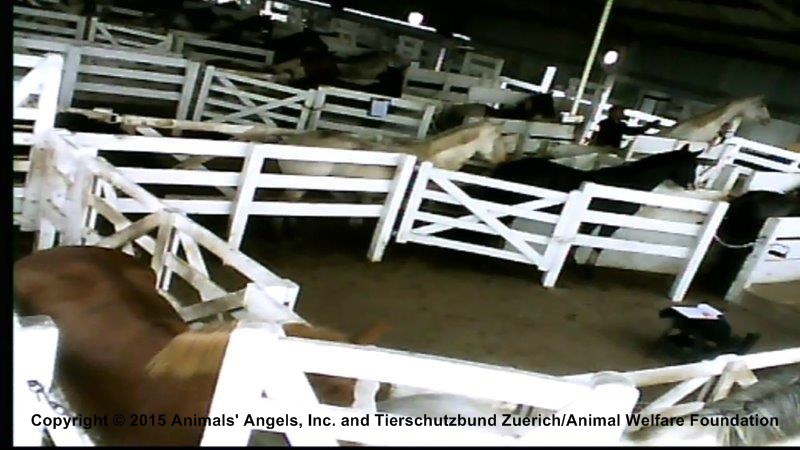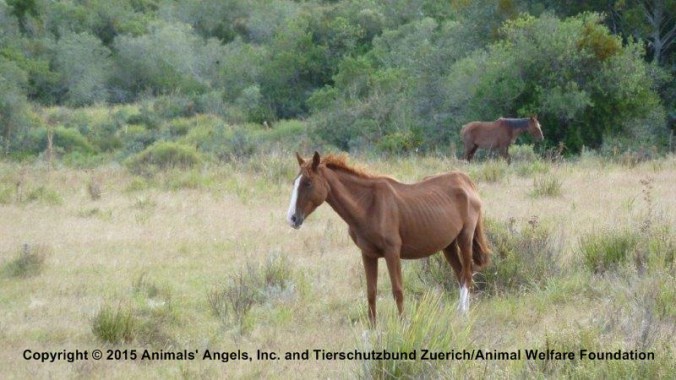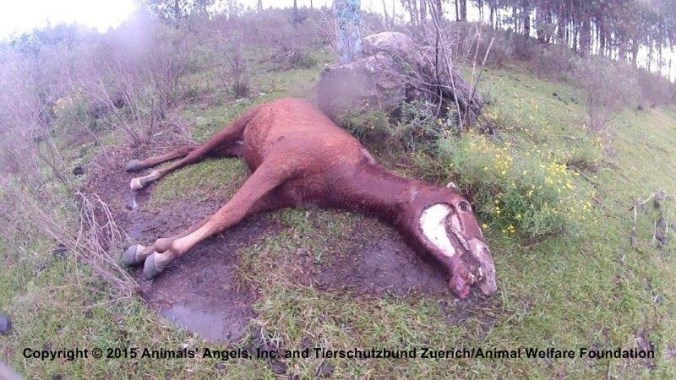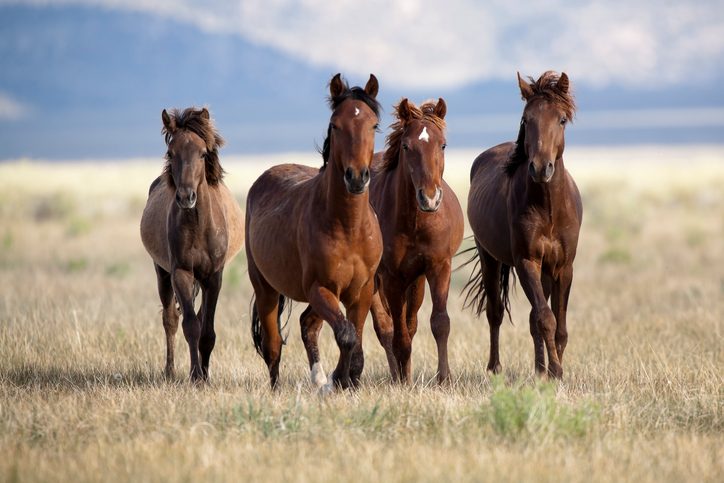The horse blood industry is little known, flying under-the-radar as it rakes in billions annually thanks to many thousands of donor horses around the globe.
In September of 2015, Animals’ Angels, along with Tierschutzbund Zuerich/Animal Welfare Foundation – both animal advocacy groups – released a report about the big business of horse blood. They revealed to the public a shadowy and, when it comes to animal welfare, loosely regulated industry.
Horse Serum and Disease
Horse serum is an “immune serum prepared from the blood of a horse that has developed immunity to toxins,” according to the Medical Dictionary. Essentially, a horse is injected with a disease and develops immunity. The horse’s blood is then drawn, the plasma separated. The serum then acts as a growth medium for viruses and bacteria in the laboratory to develop vaccines and drugs.
A 2007 New York Times article tells the story of horses as heroes in developing the diphtheria vaccine. According to the article, as early as 1890 physicians Emil von Behring of Berlin and Émile Roux of Paris developed an effective diphtheria antitoxin. The process involved injecting horses with diphtheria and repeating the doses over a period of time. These injections occasionally proved fatal, but many survived their symptoms and, in turn, developed immunity to the disease.
The doctors then drew the immune horses’ blood, using the serum to create a vaccine for humans that proved effective in over 50% of human cases. While sheep, dogs, and other animals were also used, the horses’ size allowed them to handle the toxins unlike smaller animals that more often succumbed to the injections.
A high-rate of allergic reactions in humans, called “serum sickness,” has meant horse serum is no longer used in many vaccines, though it remains vital in the production of anti-venoms. Snakes are “milked” for their venom, which is then injected into horses and, as with diptheria, an anti-toxin for humans is created with the horses’ immune serum.
Donor horse serum is also used to create autogenous vaccines which are “customized treatments to address specific equine health concerns,” according to a spokesperson from Rocky Mountain Biologicals, a producer of animal serums. The spokesperson ads, “sometimes it’s necessary to make a few horses sick in order to save the lives of others.”
Donor Herds in America
Locating donor herd farms is not an easy task, as they are typically in rural areas and don’t advertise their existence.
One location investigated by Animals’ Angels was Central Biomedia, located in Irwin, Missouri. Central Biomedia uses mostly draft horse geldings for serum production, but proprietary agreements don’t allow them to disclose their customers in the biotech industry. They currently maintain approximately 200 horses.
The Animals’ Angels report includes images of a dramatically underweight donor horses and muddy conditions in the pens, though no outright abuse was documented.
A spokesperson for Central Biomedia says their products are used primarily in stem cell research, so rather than the horses being tested directly with a product, the serum is used in a test tube or on a plate. “It’s a lot more benevolent than the Animals’ Angels article would leave most to believe,” they say.
Central Biomedia’s website advertises the care and treatment their donor horses receive at the Missouri farm. They fail to mention what happens to the horses no longer capable of being donors, whether due to age, illness, or other reasons.
When asked about the origins and ultimate fate of the horses, Central Biomedia wasn’t always able to provide a direct answer. The company did share that most donor horses are purchased from the Amish because they don’t use many vaccines and the horses’ blood is considered more “pure.” Horses are acquired through an undisclosed middleman; if a horse proves unfit for donation, Central Biomedia returns the horse to the middleman.
Central is quick to add that their herds are maintained by strict SOPS (standard operating procedures). “The people buy the serum for the biotech industry come and audit, and the USDA comes to audit,” says a spokesperson, though such procedures are intended to ensure the quality of product, not the care of the animals producing it.
Quad Five, another known producer of animal blood and serum products located in Montana, maintains a herd of 80 donor horses. They use Percherons, Belgians, and Quarter horses. According to Quad Five, “the majority of horses are purchased at Waverly IA (a well-known horse auction) as broke teams so as to always have a partner.”
The retired horses are kept at a separate facility and live until they pass away. Quad Five provides feed and care, claiming some of their retired horses have lived until 35 years of age.
Quad Five and Central Biomedia are both USDA approved facilities. Licensed products are subject to USDA inspection and animals are regularly tested for disease, ensuring products are not tainted. Still, many serum producers are far less forthcoming about their products and operations, remaining largely unregulated. According to an American Association of Equine Practitioners (AAEP) white paper on the subject, “equine plasma and serum products which make no disease or treatment claims are manufactured and sold with no regulatory oversight.”
Anytime one being is made sick for the sake of another, there naturally arises an ethical gray area. But it’s the big business of pregnant mare’s serum gonadotropin (PMSG) that’s of specific concern for animal rights groups.
Pregnancy, Donation, Abortion, Repeat…
PMSG, also called Equine Chorionic Gonadotropin, is a hormone produced by pregnant mares, usually between days 40 and 130 of gestation. Their blood is extracted and separated during this time, the hormone-rich serum used to create animal-industry drugs that induce ovulation prior to artificial insemination. The major concern in PMSG production is the welfare of mare and baby. In most cases, the mares are aborted during their pregnancy. In cases where they are carried to term, foals may face slaughter or be used for the same purpose as their mothers.
The biggest use of PMSG is in the hog production industry, where by inducing estrus in sows, pregnancy occurs more frequently and results in greater efficiency for hog production plants. While this may not sound like a groundbreaking product, without PMSG, hog production would likely decrease, effecting profits for this multi- billion dollar industry.
Merck Animal Health produces a drug called PG600, which contains PMSG. PG600 induces ovulation in gilts (female pigs that have never given birth) and sows. The company has a second drug containing PMSG, Folligon, which is used for the same purpose in cows, sheep, and swine.
A spokesperson from Merck refused to disclose sales information and, due to proprietary guidelines, could not disclose their major purchasers. However, a veterinarian from Smithfield foods – the world’s largest pork processor and hog producer – confirms that PG600 is used in their hog production program.
Smithfield, a subsidiary of Shuanghui Group, raises approximately 15 million pigs per year and produces roughly 6 billion pounds of pork. In 2014, they reported sales of $15 billion. Smithfield’s sows produce 2-3 farrows (that’s pork industry-speak for litter) per year. In order for a “feeder-to-finish” pork producer such as Smithfield to remain at peak production, sows must be highly efficient. If a sow doesn’t come into cycle soon after weaning, PG600 or similar drugs will be used to induce ovulation.
It’s a vicious cycle: mares are made pregnant and aborted to get sows pregnant, their piglets born to die.
The blood farms where PMSG is collected are located around the world, often tucked away and secretive. “It’s a very hidden, secretive industry,” says Sonja Meadows of Animals’ Angels. “The donor herds are kept away from the public view, in very rural and remote areas that are almost impossible to access.”
The Animals’ Angels/ Tierschutzbund investigation took them to South America where they investigated Syntex S.A., a major producer of horse serum with locations in Argentina and Uruguay.
Animal abuse was evident in the handling of horses at the Syntex location in Argentina. Handlers were documented using electric prods and were seen hitting a mare in the head with a wooden board. Wobbly horses on the verge of passing out after the blood draws were kicked and hit when unable to move. Some mares attempted to jump out of the blood drawing facilities and away from the handlers.
At Syntex’s Uruguay location, investigators began at a property called “El Yatay,” where mares and foals were seen living in a large eucalyptus field. They noted some mares had untreated wounds and were quite thin, their ribs obviously protruding. The investigators learned that the blood was drawn on a farm, called “Loma Azul,” 3.5 hours from El Yatay where the pregnant mares would be transported and spend around 5 months for blood draws.
Their source at El Yatay estimated that 800 horses were kept on the property, while an additional 2200 were kept at Loma Azul. Another source stated that Syntex is one of the largest suppliers to the Clay horse slaughter plant, the mares being discarded once no longer fertile. The source estimates 795 horses were shipped to slaughter in 2014.
At the time of the Animals Angels’ report release in September of 2015, Syntex Uruguay alone had shipped over $33 million in horse serum to the European Union.
Investigations of multiple other “blood farm” properties in Uruguay were conducted with similar results. Bones, a skull, and a dead, rotting mare were found in pastures. For the mares living, they were often thin and endured a life of pregnancy and abortion.
Dr. Cabanas, president of the National Animal Welfare Committee in Uruguay told investigators that he believes “foreign pharmaceutical companies take advantage of the fact that in some developing countries there are no laws regulating the production of PMSG and consequently no controls.”
Beginning in 2015, Merck Animal Health began obtaining their serums from locations in Chile, Uruguay, and Iceland, though Merck was unwilling to disclose the specific blood farms they use.
A spokesperson from Merck expressed outrage at the treatment of pregnant mares at Syntex’s facilities following the Animals’ Angels report. “Even though we knew Syntex was not a supplier of ours we went ahead and sent veterinarians of ours to all our suppliers, in particular to Uruguay. We wanted to ensure they were following protocols we put in place and were treating animals in an appropriate manner.”
When asked about backlash following the report’s release, Meadows says the pharma companies and blood donor farms remained mostly silent. But when the story was was picked up by several international news stations, some were forced to respond. The director of Syntex Argentina, Dr. Ignacio Videla Dorna, admitted during a T.V. interview with DW Noticias that abortion was a regular part of the donor program, but insisted they take good care of the animals because they are valuable to their business. Workers filmed harming the horses were dismissed.
The report also prompted Suisseporcs, the Swiss Pig Breeders’ association, to call on pig breeders and veterinarians to stop using products containing PMSG. The Swiss Veterinarians GST also spoke out against use of the drug PG600 after Merck Animal Health refused to answer their questions regarding animal welfare standards.
An obvious solution to the problem would be the use of synthetics in developing these drugs, though the science is not yet there. According to the spokesperson from Merck, “It’s something we’re always looking into, but as of today there’s nothing available on the market. Synthetic hormones are in development but break down too quickly in the system and are excreted, proving useless.”
A spokesperson from Rocky Mountain Biologicals agrees synthetics would be ideal. “Biopharmaceutical and animal health industries are eager to move away from the animal-based products, largely due to concerns about animal welfare. However, like human-donated serum, blood, and plasma, serum remains the most effective medium in some medication development.”
If synthetics are not an option, the question has to be asked whether these drugs are necessary. If the answer is yes, how can these donor horses be protected?
In America, donor herds should be protected under the Animal Welfare Act, which protects animals used in research. While this protection would be progress, Meadows is skeptical. “Regular inspections under the AWA would be a good start. However, it is very questionable that these inspections could guarantee humane treatment and adequate care – especially given the USDA’s ongoing budget cuts.”
Even if the Animal Welfare Act were to cover these horses, and inspections successful, the question of PMSG donor horses elsewhere remains of great concern.
Due to the near impossibility of ensuring the welfare of these horses, Animals’ Angels, along with their European counterparts, are “calling for a complete stop of PMSG production.”
In medicine, there are sacrifices made in the name of life-saving progress. But in the case of PMSG where it’s profit – not lives – on the line, the means and motives need to be reexamined.
Article by Ashley Fairfield-Remeza
Sources
http://www.thehorse.com/articles/34604/improving-anti-venom-donor-horses-welfare
http://www.ncbi.nlm.nih.gov/pubmed/24582735
http://farmersweekly.co.nz/article/bsa-plant-to-be-built-in-feilding?p=12
http://billingsgazette.com/news/features/magazine/bleeding-for-the-world-blood-products-fedexed-from-ryegate-to/article_893dcdde-8b11-5331-a0b5-e26b13441c16.html
http://www.abc.net.au/landline/stories/s745329.htm
http://www.vetfolio.com/infectious-disease/survival-of-foals-with-experimentally-induced-em-rhodococcus-equi-em-infection-given-either-hyperimmune-plasma-containing-em-r-equi-em-antibody-or-normal-equine-plasma
http://www.who.int/bloodproducts/snake_antivenoms/snakeantivenomguideline.pdf
https://www.reddit.com/r/askscience/comments/1y19o2/how_does_antivenom_work/
http://quadfive.com/index.php?option=com_content&view=article&id=11&Itemid=118
http://tierschutzbund-zuerich.ch/en/investigation-reports/project/select_category/64.html
http://www.fda.gov/BiologicsBloodVaccines/Vaccines/QuestionsaboutVaccines/ucm143521.htm
http://www.ehow.com/list_6862070_list-vaccines-derived-horse-serum.html
http://medical-dictionary.thefreedictionary.com/horse+serum
accines.org/content/articles/passive-immunization
http://www.ask.com/pets-animals/horse-serum-used-46d34e76d155c287
http://www.nytimes.com/2007/07/10/health/10hors.html?_r=0
https://en.wikipedia.org/wiki/Equine_chorionic_gonadotropin
http://tierschutzbund-zuerich.ch/en/contact-us/office.html
http://quadfive.com/index.php?option=com_content&view=article&id=11&Itemid=118
http://www.dw.com/es/las-polémicas-prácticas-del-laboratorio-syntex/av-18837631
https://globenewswire.com/news-release/2015/03/25/718572/10126248/en/Smithfield-Foods-Reports-Record-2014-Results.html






April 29, 2016 at 9:27 pm
that is not right horses are a gift from god it you need to talk to me go to my facebook it Penny Fick the pic has a horse and dog on it.